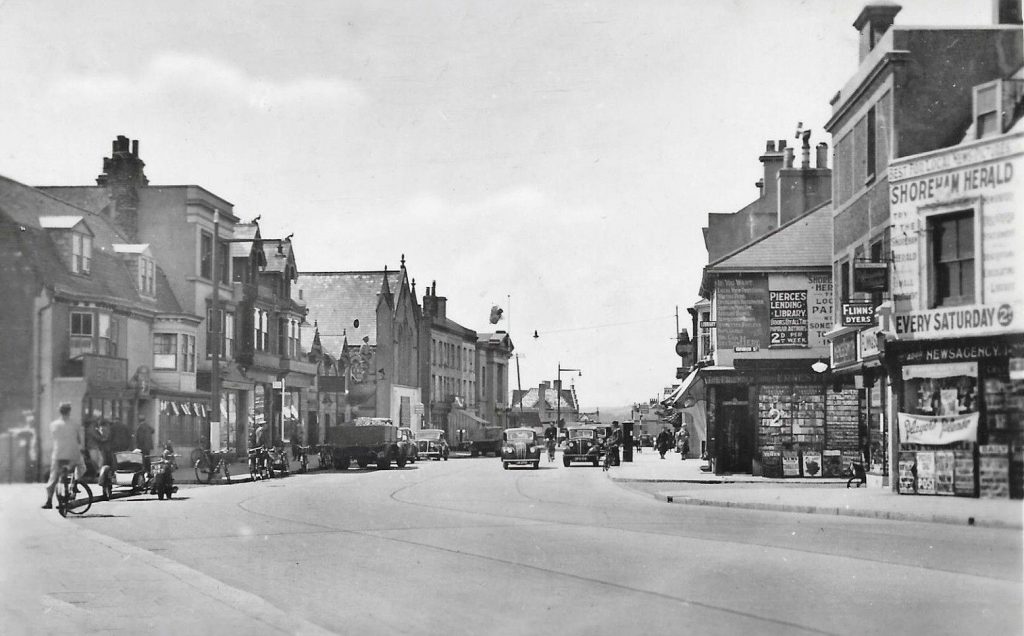Bessie Bailey remembers Bungalow Town life between the Wars.

Roger Bateman articles, blog posts and pages
Shoreham’s Past Recalled – BBC Local Radio interview with David Tait of the Shoreham Society in 1994.

A Village Afloat – The Riverbank – A radio programme (from 1988).
Listen to Fred Clarke’s delightful Sussex accent as he describes his time at work in the boatyard and Bungalow Town during WW2

Shoreham Memories BBC Radio programme about Bungalow Town.


Built as a Custom House in 1830 by George Henry Hooper at the expense of the ancient Poole family mansion that had stood on the same site for centuries before. Hooper was himself a descendant of the Poole family and the new building was, initially at least, an attractive one designed by Sydney Smirke R.A, but its appearance was somewhat compromised during the subsequent enlargements of 1920.
Continue reading “The Old Town Hall”– a collection of images from the galleries and collections of shorehambysea.com illustrating the changes to the area since the 18th century.

What a wonderfully eccentric place it was! Besides a fascinating ropemaking and shipbuilding past there were, in Victorian times, ancient buildings still standing, quaint cottages, wharf houses, a gas works and, spookily, a mortuary alongside an incinerator! In the Little High Street there were peculiarly shaped houses and strange, shop-like windows.
It was never a fashionable area, being part industrial and part residential where the poorer, labouring families largely dwelt. In 1817 William Butler’s poor grammar described it as being “the lower ‘hend’ of town” and goes on to mention a ‘pour new’ shop where he had ‘connections’ with Sarah Fillaps. Something of a mystery and perhaps a pawn shop (a corruption of the French ‘for us’) or as William’s escapades suggest one of the numerous brothels in Shoreham port then?
During the early part of the 19th century Ropetackle included wharf houses, sheds, a brickyard, coal yard, a bonding pond, Thomas Clayton’s deal yard, his cement factory, stables, a mixture of 17th to 19th century houses and even a mill pond. By the Victorian era there was also a sewage plant and of course the gasworks, flint-built ware houses, incinerator and mortuary. It all added to a certain air of eeriness and mystery to the area.
Continue reading “Ropetackle – the last 300 years”Southlands Hospital’s origin can be traced to the Steyning Union Workhouse that was built in a different location, at Ham Road, in central Shoreham in 1836. Later additions included infirmaries built in 1870, vagrant’s wards and a chapel. The union included parishes in East and West Sussex and the growth of population in its coastal areas meant that, despite much additional building, an enlarged site was required by the 1890s.
Continue reading “Southlands – Workhouse and Hospital”Naval sketches of the fourth rate, 48 guns, three-decked man-of-war HMS Dover, built at Shoreham in 1653, give the impression of a very large ship. Surprisingly at 533 tons and keel length of 104 feet it was very similar in terms of length and tonnage to many of Shoreham’s typical 19th century home built merchantmen such as the Shamrock 500 tons/117 feet; Agricola 600 tons/119 feet and Cambria 500 tons/116 feet.
Visual comparisons perhaps give more idea of sizes and this view of an average 19th century vessel between the Dover (left) and the considerably larger Britannia (right, recorded at 800 tons and a length of 140 feet) reveals a perhaps diminutive but nevertheless beautiful example of Shoreham’s shipbuilding history.